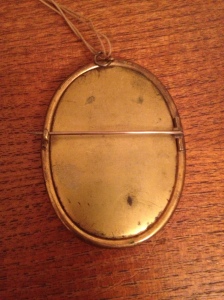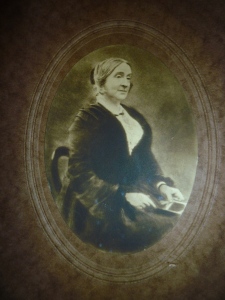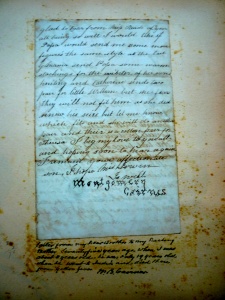11. Montgomery Cairnes 1789 -1877

Back of Brooch. 8cmcx 5cm. Probably made as a keepsake for his mother. Thanks to Colin Montgomery Cairnes for the photos.
Montgomery Cairnes was born on April 15, 1789 in County Tyrone, Ireland. He was born in turbulent times. He was the 4th of 7 children.
It was the year of the French Revolution and that struck terror in the heart of those powerful families in Ireland that supported the British Monarchy and way of life. There were real fears that France may invade Ireland and help the Irish republicans .
Below are some wiki details of the times. One can understand why many of the landed gentry encouraged their sons to join the officer class.
“In 1789 the French Revolution occurred during which French peasants overthrew the monarchy. Out of the bloodshed emerged a new democratic French republic. For many peasant people across Europe, this new democracy concept was very appealing, since it gave the power to them and not to the aristocracy. In 1791, the newly installed French government offered military assistance to any group who wanted to overthrow their own King. This was very worrying for the surrounding monarchies of England, Spain, Germany and Austria and war soon broke out between them and France.
At the same time, a new organisation was formed in Ireland. Under Wolfe Tone, the United Irishmen (who consisted of Protestants and Catholics alike) declared their belief in a peaceful future for Ireland in which Protestants and Catholics could live together in peace and with equality. They wanted to set up a French-styled democratic republic in Ireland, which was independent of Britain. They quickly gained support, although some, most notably the newly-formed Orange Order which was set up to preserve loyalty to the monarchy, were against them.
Supporting French Republicanism was seen as treasonous by the British considering they were at war with France. Also, Britain was a constitutional monarchy, which meant that the King did not have absolute power. Therefore the British regarded themselves as already democratic. Because of these facts, the British saw the United Irishmen as a national threat to be disposed of.
In 1798, the British began attacking known United Irishmen, and murdering large numbers of Protestant and Catholic members. Tone realised that if they were going to have their rebellion, it would have to be now or never, before the British destroyed them. So a large rebellion began in the spring concentrated in counties Down, Antrim and Wexford. Several bloody battles took place at Antrim, Ballynahinch and Saintfield. The United Irishmen were finally defeated at the Battle of Vinegar Hill in County Wexford. Almost all the several hundred United Irishmen were slaughtered.
However, it was not over. In late 1798, the French sent reinforcements to Ireland and they landed at Mayo, in western Ireland. They invaded and took over the area and gained popular support among the local Irish who saw it as an opportunity to get a better government. The French and their Irish allies got as far as county Sligo before being defeated by the British. While the French were taken prisoner, the local Irish were massacred as a punishment for treason. Wolfe Tone committed suicide in prison whilst awaiting execution. Note that this was the last time a hostile army ever invaded Ireland.
Although the rebellion had been put down, it was clear that Republicanism in Ireland could not be ignored and serious changes were needed in the way Ireland was governed to ensure that such violence did not occur again.
The drastic action that was taken was the Act of Union, passed in 1800. It formed a new country (“The United Kingdom of Great Britain and Ireland”) by uniting England, Wales, Ireland and Scotland. A new flag – the Union Jack – was created for it which had components from the flags of each member state. All regional parliaments were abolished, and instead the entire UK was to be ruled from a centralised London parliament. For most Irish, there wasn’t a noticeable difference, but it meant the Irish government representatives could not pass laws on their own.”
Parents and Siblings
His mother was Catherine Moore of Moore Hall, County Down Ireland (1758-1838) , his father was John Elliot Cairnes of Saville Lodge, Tyrone (1745-1802 ).

Moore Hall, where Monty’s mother, Catherine Moore, was raised. Burnt down in 1920’s by republican rebels.
They were all connected by marriage to some of the most influential landowners in Ireland. The Montgomery’s of Grey Abbey, The Bellingham’s of Castle Bellingham, The Woolsey’s of Priorland House, County Louth, the Beresfords of Waterford and the Menzies of Scotland. Many were educated at top ranking schools in England and then either Oxford or Cambridge and many were bought commissions in the military. Many were MP’s or went into the clergy.
His sister Ann Cairnes was born in 1783 but there are no details of her life. Perhaps she died in infancy.
His eldest Brother John Elliot Cairnes ( there were a few of them, the most famous being Prof John Elliot Cairnes the economist , son of Monty’s brother William) became a Colonel. He was involved with the Duke of Wellington , an Anglo Irish, in the Napoleonic wars.
His next brother, William, went into the brewery business with his father -in-law William Woolsey and eventually set up his own brewery in Drogheda. He bought and lived in Stameen House which is now a hotel. The Brewery was eventually sold out of the family in the 1960’s and became Grants of Ireland. A gastro pub named Wm Cairnes was opened in 2012 in the dockland building where the original brewery was. One can still buy a boutique beer there. And you can still buy the tin sign shown below from here.
His younger brother, Alan Bellingham, was also in the military and died age 19 , at the Siege of Badajoz, Spain, fighting Napoleon.
His youngest living brother Henry ( George ) Moore Cairnes lived till he was 82 and died in Armagh. Two of Henry’s sons migrated to Australia a little after WBC in the mid 1800’s. They were Elliott Moore Cairnes and Claudious Beresford Cairnes.
Finally, his younger brother James Elliot Cairnes died in infancy.
It is not clear where his military training was, although he started in the 50th Regiment and then the 60th regiment based in England.
His Wife and Family
It is uncertain when exactly or at what age Montgomery moved to Quebec. He was moved from Lieutenant in the 50th Foot to Captain of the 60th in 1815, which was posted in Canada, so its likely he made his way to Canada in 1815/16 aged 26.
He married at age 27, in 1817, Theresa Holmes the 4th and youngest daughter of William Holmes MD, the Surgeon General of Quebec. Dr Holmes had previously been a captain in the same regiment as Monty – the 60th. Theresa and Monty were cousins. She was 10 years his junior. William Holmes had been born Stewarts Town, County Tyrone, Ireland, and was related to the Cairnes Family. The Holmes family was extremely prosperous. Its who you know. Theresa’s mother was descended from one of the Filles du Roi, sent from France by the King in the mid 1600’s to marry the French settlers. Quite a pedigree.
His first child Mary Ann Arabella Cairnes was born in October 1818, in Summer Hill, Dublin. Sadly she died the following year 1819, aged 6 months. She is buried in Clontarf, Dublin.
His second, Catherine Matilda Cairnes was born in August 1819 in Jersey. She dies aged 14, in 1833, at Miss Moores Boarding School, Dublin. ( note : is Miss Moore one of the Moores at Moore Hall? Monty’s mother was Catherine Moore of Moore Hall which was pretty much burned to the ground by Irish rebels in 1922, but thats another story)
William Henry Torrens Cairnes was born in Soho Square in London in 1820. He dies aged 15 months in Quebec, Lower Canada, in January 1822.
His second son Montgomery Cairnes was born June 1823, in Halifax, Nova Scotia. He dies in Port of Trinidad, Spain in 1842 aged 19, of Yellow Fever. Though the letter below in WBC’s album says simply the Indies. There is no record so far of why he was there.
His third daughter Theresa Sophia was born on 1825 in Pimlico London. She accompanied WBC on the ship to Australia in 1853 and shortly thereafter marries a Phillip Clements in Castlemaine Victoria in 1853. (Perhaps we can assume it was a marriage with someone known to the family back in Ireland . Perhaps WBC , who also settled in Castlemaine , had chaperoned her on the outward journey. It is unlikely that the two young Cairnes’ from such a high status Irish family would have travelled so far without a predetermined motive or destination.) She dies in Northcote, Melbourne, in 1911 aged 85.
And lastly his youngest son, my great grandfather, William Bellingham Cairnes who arrived in Australia aged 23 and lived till his 90th year.
Military Career.

an oil painting of Capt. Montgomery Cairnes Dublin which was possessed by my fathers brother Alan Bellingham Cairnes
Monty was promoted from Leiutenant in the 50th Queens Own Rifle Corp to Captain of Company of the 60th in 1815.
By 1816 he was with the 60th Royal Rifle corps based in Quebec.
Monty was at some point Aide de Camp ( or Chief of Staff) to the Lieutenant Governor in Lower Canada. Was this because Monty’s family had associations with the Surgeon General back in Ireland. It was indeed a highly responsible position and likely he served in this position after he married. And of course anyone could see he would look rather lovely in uniform, standing beside the Governor. A PR plus in anyones books.
See this link for more details: http://en.wikipedia.org/wiki/King’s_Royal_Rifle_Corps
The 60th were uniformed and equipped in a similar manner to other British regiments with red coats and cocked hats or grenadier caps,[5] but on campaign, swords were replaced with hatchets, and coats and hats cut down for ease of movement in the woods.
He was then in the 81st Regiment of Foot. Also garrisoned in Canada, though this regiment seemed to miss out on all the major skirmishes in the Americas and in Europe in the first half of the 1800’s. http://en.wikipedia.org/wiki/81st_Regiment_of_Foot_(Loyal_Lincoln_Volunteers)
Below are some postings found on the internet.
London Gazette September 7, 1815 Lieutenant Montgomery Cairnes of 50th Foot to be made Captain of Company in 60th Foot.. Without purchase, vice Knipe. Placed on half pay.
In the book A Good Wise Measure – The Search for the Canadian- American Boundary by Francis M Carroll, Capt. Montgomery Cairnes , an engineer from the 81st Regiment, who was a member of the British party ( there were French, British and Americans doing the surveying) is mentioned in several pages. It says he was able to stave off starvation in the group by catching trout! The mention of him as a talented fisherman and an engineer resonates in many of his descendants in Australia. This all occurred in 1817/18 around the time he wed Theresa. This is a most interesting piece of information. Our Monty was on the spot when the borders of Canada and USA were surveyed. A great piece of history.
In the Military Register for Jan 31 1821, Montgomery Cairnes , Cork outbound to Nova Scotia is made a captain with the 81st Foot.
In 1844 an Epic National Poem “Fingal” was dedicated to Colonel John Elliott Cairnes. Captain Montgomery Cairnes, of 4, Dalymount Terrace was listed among the many subscribers, all who appear to be the great and good of Ireland and regions around.
Below are a couple of entries in the Melbourne Argos regarding the deaths of Montgomery and his wife, placed by William B Cairnes their only surviving son.
“Captain Montgomery Cairnes Aid de Com (sic) to Governor of Canada. Died approximately 1877.”

An oil painting of Theresa Holmes Cairnes which was in the possession of my fathers brother Alan Bellingham Cairnes
“On the 19th inst. at Castlemaine, Victoria,
Australia, Theresa, relict of the late Captain Mont-
gomery Cairnes, late aide-de-camp to Sir Ronald
Ferguson, in Holland, also aide-de-camp to Sir
George Don, Governor of Gibraltar, and beloved
mother of W. B. Cairnes, timber merchant, Yarra-
wonga, aged 88 years.
On the death of his father, WBC went back to Ireland for the first time in 24 years. His parents had spent their last decades without the company of their youngest offspring. WBC brought his mother back to Australia 4 months later, where she was joined with both her daughter Theresa and her family, and William’s large family. I wonder what Theresa senior thought of the miners daughter her baby son had married. It would have been a far cry from the privilege she left behind in both Canada and in Ireland. The strictures of Class delineation would have well and truly been challenged.

Poem claimed by WBC to have been written by Montgomery in 1863, but its provenance has now been attributed elsewhere.
The poem is the third verse of a 3 verse hymn, the words were written by one Robert Grant MP – a contemporary of Montgomery, and were included in hymnals in 1835 and 1839. It is very poignant that M wrote out the verse given that he’d lost four (?) children …! I must thank Emily Deller ( WBC is her grt grt grandfather ) for this discovery.







